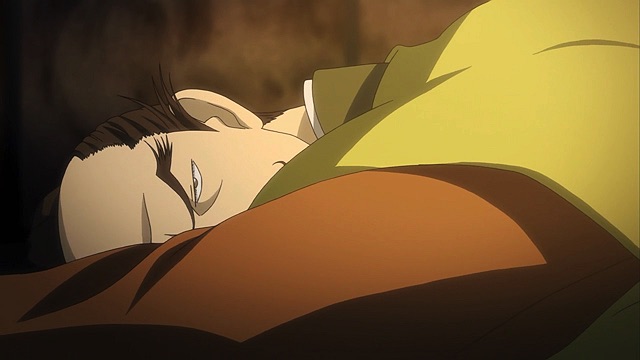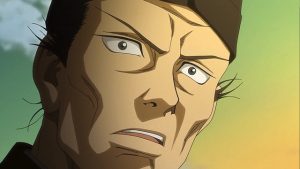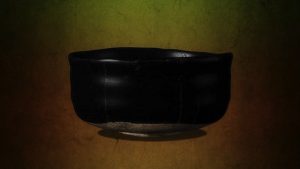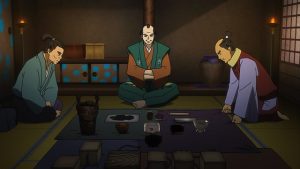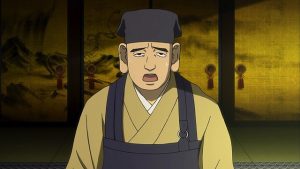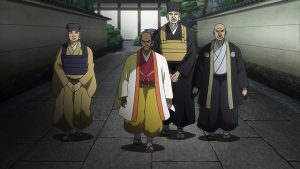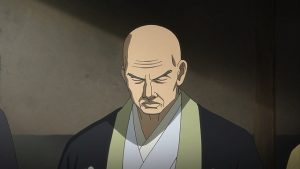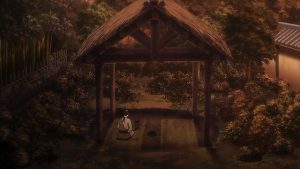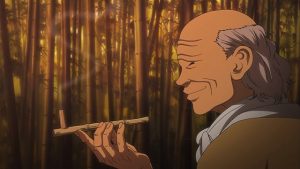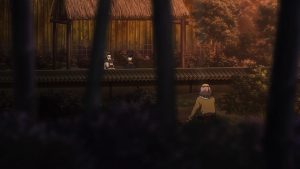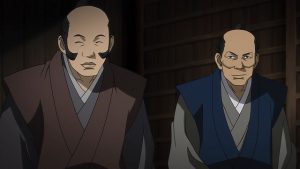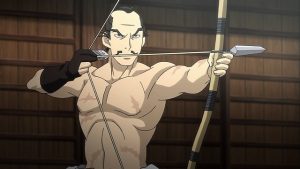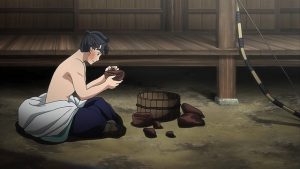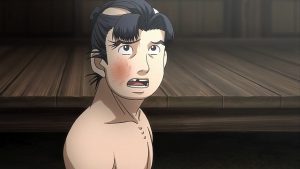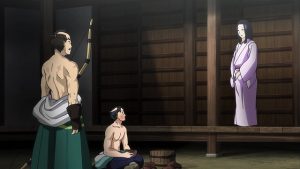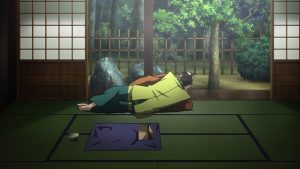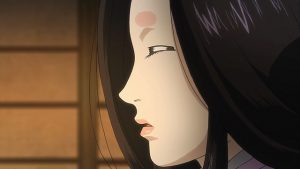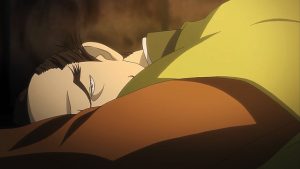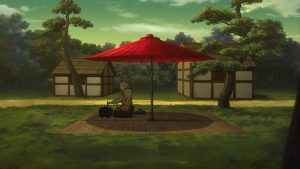 You wouldn’t think an episode about what’s essentially a tea ceremony rap battle would be this tense, but Hyouge Mono is full of defied expectations. It veers constantly between history and fantasy – I believe this ep to be mostly the latter – to the point where it’s hard to tell where one ends and the other begins. And frankly I’m not sure it matters all that much, because our view of Japanese history is full of the interpretations of others. This is a culture that’s always recorded its history more in the continuity of its traditions and rituals than in historical texts.
You wouldn’t think an episode about what’s essentially a tea ceremony rap battle would be this tense, but Hyouge Mono is full of defied expectations. It veers constantly between history and fantasy – I believe this ep to be mostly the latter – to the point where it’s hard to tell where one ends and the other begins. And frankly I’m not sure it matters all that much, because our view of Japanese history is full of the interpretations of others. This is a culture that’s always recorded its history more in the continuity of its traditions and rituals than in historical texts.
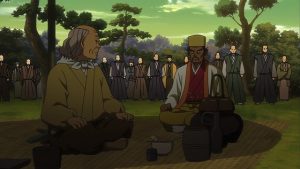 There is a kernel of truth at the core of these events, and that’s the fact that Hideyoshi did sour on Sen no Rikyu after many years of seemingly adoration and deep respect. Hideyoshi was notoriously capricious when it came to personal relationships (see the Kyushu affair with the Portuguese), and we’re often left to speculation as to why he turned on close associates. What we know is that he did turn on Rikyu (I won’t “spoil” in the event anyone doesn’t know the history), and the most likely reason seems to be the one posited here, that he saw Rikyu’s rising influence as a threat.
There is a kernel of truth at the core of these events, and that’s the fact that Hideyoshi did sour on Sen no Rikyu after many years of seemingly adoration and deep respect. Hideyoshi was notoriously capricious when it came to personal relationships (see the Kyushu affair with the Portuguese), and we’re often left to speculation as to why he turned on close associates. What we know is that he did turn on Rikyu (I won’t “spoil” in the event anyone doesn’t know the history), and the most likely reason seems to be the one posited here, that he saw Rikyu’s rising influence as a threat.
 Hosokawa is of the opinion that Hideyoshi is simply too flighty, always attracted to new things – and there may have been an element of that here, too. A temperamentally ostentatious man probably chafed at the restraints of imperfection and simplicity as proscribed by Sen no Rikyu. But this seems mostly to be about politics. Hideyoshi is about to crown Hechikan as the champion of the Grand Kitano Tea Ceremony – and effectively the new #1 aesthete and tea master – when Sasuke begs him to hold off. This is fine with both of them, as Hechikan is horrified at the idea and Hideyoshi would rather bestow the title on the Hakata merchant Souton Kamiya. So he agrees to a showdown between the two (and Souton, if he arrives in time).
Hosokawa is of the opinion that Hideyoshi is simply too flighty, always attracted to new things – and there may have been an element of that here, too. A temperamentally ostentatious man probably chafed at the restraints of imperfection and simplicity as proscribed by Sen no Rikyu. But this seems mostly to be about politics. Hideyoshi is about to crown Hechikan as the champion of the Grand Kitano Tea Ceremony – and effectively the new #1 aesthete and tea master – when Sasuke begs him to hold off. This is fine with both of them, as Hechikan is horrified at the idea and Hideyoshi would rather bestow the title on the Hakata merchant Souton Kamiya. So he agrees to a showdown between the two (and Souton, if he arrives in time).
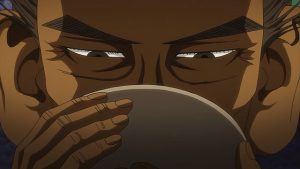 I don’t believe we’ve seen Souton in the story before (it’s been like 7 years so forgive me if I’ve forgotten), but it’s not hard to see the appeal to Hideyoshi. He’s a merchant from the far south of Japan and not a local noble, and not especially ambitious. Problem is, he’s so unambitious that he has no interest in being the #1 aesthete, leaving Hideyoshi convinced he has to award it to Hechikan given Sasuke’s noble status. But Hideyoshi’s brother and Hechikan conspire to sabotage the plan by bringing the chief advisor’s mother (a huge Rikyu otaku) in from Osaka.
I don’t believe we’ve seen Souton in the story before (it’s been like 7 years so forgive me if I’ve forgotten), but it’s not hard to see the appeal to Hideyoshi. He’s a merchant from the far south of Japan and not a local noble, and not especially ambitious. Problem is, he’s so unambitious that he has no interest in being the #1 aesthete, leaving Hideyoshi convinced he has to award it to Hechikan given Sasuke’s noble status. But Hideyoshi’s brother and Hechikan conspire to sabotage the plan by bringing the chief advisor’s mother (a huge Rikyu otaku) in from Osaka.
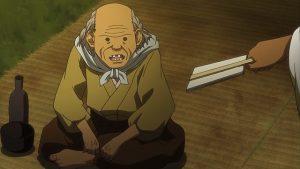 As for Sasuke, he tries to one-up his absurd treehouse teahouse by staging an “ancient times” tea ceremony in a pit, complete with loincloth and beating drums. Sen no Rikyu finally acknowledges the elephant in the room here – while it’s amusing, none of this is simplicity or imperfection. It’s pretentious twaddle, as the vast majority of this imperfection stuff is. It’s devastating for Sasuke to hear it but it’s the truth. In point of fact Hechikan is really the only one who seems to get the whole aesthetic, and actually manage to be pretty authentic about it.
As for Sasuke, he tries to one-up his absurd treehouse teahouse by staging an “ancient times” tea ceremony in a pit, complete with loincloth and beating drums. Sen no Rikyu finally acknowledges the elephant in the room here – while it’s amusing, none of this is simplicity or imperfection. It’s pretentious twaddle, as the vast majority of this imperfection stuff is. It’s devastating for Sasuke to hear it but it’s the truth. In point of fact Hechikan is really the only one who seems to get the whole aesthetic, and actually manage to be pretty authentic about it.
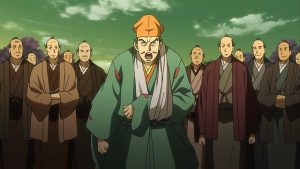 “More than enough is too much” is the kernel of Confucian (I suppose he might have said it) wisdom Sen no Rikyu uses to sum up Sasuke’s entire pretentious life. We see Sasuke in the aftermath – a careful and thoughtful administrator, a father, a husband – a man who’s generally better at peace than war, but competent in both. Yet he’s eternally restless, driven by the relentless desire to put his stamp on the world through aesthetics. It’s an odd trait for the protagonist of an anime, but protagonists – and anime – don’t come much odder than Furuta Sasuke and Hyouge Mono.
“More than enough is too much” is the kernel of Confucian (I suppose he might have said it) wisdom Sen no Rikyu uses to sum up Sasuke’s entire pretentious life. We see Sasuke in the aftermath – a careful and thoughtful administrator, a father, a husband – a man who’s generally better at peace than war, but competent in both. Yet he’s eternally restless, driven by the relentless desire to put his stamp on the world through aesthetics. It’s an odd trait for the protagonist of an anime, but protagonists – and anime – don’t come much odder than Furuta Sasuke and Hyouge Mono.


